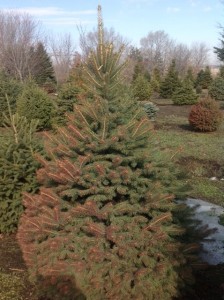 Colorado Spruce Tree with winter burn Spring of 2014
Colorado Spruce Tree with winter burn Spring of 2014
Now that the snow melt is almost complete, I have been walking through the fields getting ready for Spring digging. One thing that is very evident on some trees is the toll a harsh winter can take on evergreen trees. What the picture is showing is called Winter Burn. Basically what has happened is the long cold winter, strong wind & sunlight has been harsh enough to dry out some outer needles, causing the needles to turn brown. The degree of browning of the needles varies on each tree. Some factors that affect how severe the winter burn is on each tree are species of tree, location of the tree on your lot & how much moisture was in the ground around the tree when the ground froze.The good news is as the new growth comes on in the Spring, the brown needles will fall off and the tree will get its true, beautiful color again. To try to avoid a severe winter burn in the future for evergreen trees in your landscape do these 2 preventative measures. Fertilize your evergreens with a fertilizer specifically made for acid loving plants during the spring & early summer. Follow label directions. Also make sure you thoroughly water evergreens in late fall. Evergreens take in moisture all winter. This should help reduce or eliminate winter burn.

